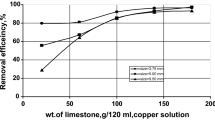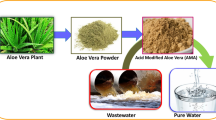Abstract
The metabolism-independent metal binding characteristics of Ulva lactuca were investigated using both freeze-dried thalli and cell walls stripped of intracellular material by incubation in Triton-X followed by methanol. Biosorption of Cd, Zn, Cu and Co by freeze-dried thallus was concentration-dependent and followed Freundlich and Langmuir isotherms. The Freundlich plot suggested that freeze-dried U. lactuca had the greatest binding affinity for Cu compared with Cd, Zn and Co. The BET (Brunauer–Emmett–Teller) plot, which indicates a more complex form of adsorption, and the Scatchard plot were not adequate models for Cu adsorption. The Scatchard plot of Cd suggested that two Cd binding sites were available on the freeze-dried thallus, with the second, lower affinity site only becoming available at Cd loading capacities greater than 4.9mmol g dry wt. Cd nuclear magnetic resonance (NMR) studies confirmed that two binding sites were available for Cd on the freeze-dried algal powder, though only one was available on the cell wall, and that the affinity of the binding sites was greater for Cu than for Cd. The results of the NMR experiments suggested that Cd binds to oxygen-containing functional groups in the algal powder and on the cell wall. It is proposed that sulphate or hydroxyl groups attached to polysaccharide subunits are possible sites.
Similar content being viewed by others
References
Armitage IA, Boulanger Y. 1983 Cadmium-113 NMR. In: Laszlo P, ed. NMR of Newly Accessible Nuclei Vol 2.New York: Academic Press; 337–365.
Babich H, Stotzky G. 1978 Effects of cadmium on the biota: influence of environmental factors. Adv Appl Microbiol 23, 55–117.
Brunauer S, Emmett PH, Teller E. 1938 Adsorption of gases in multimolecular layers. J Amer Chem Soc 60, 309–319.
Crist RH, Oberholser K, Shank N, Nguuyen M. 1981 Nature of bonding between metallic ions and algal cell walls. Environ Sci Technol 15, 1212–1217.
De Rome L, Gadd GM. 1987 Copper adsorption by Rhizopus arrhizus, Cladosporium resinaeand Penicillium italicum. Appl Microbiol Biotechnol 26, 84–90.
Freundlich H. 1926 Colloid and Capillary Chemistry. London: Methuen.
Gadd GM. 1988 Accumulation of metals by microorganisms and algae. In: Rehm HJ, ed. Biotechnology Vol. 6b Special Microbial Processes. Weinheim, Germany: VCH Verlagsgesellschaft; 401–433.
Gadd GM. 1990 Biosorption. Chemistry and Industry 13,421–426.
Gadd GM, Mowll JL. 1985 Copper uptake by yeast-like cells, hyphae and chlamydospores of Aureobasidium pullulans. Exp Mycol 9, 230–240.
Garnham GW, Codd GA, Gadd GM. 1992 Uptake of technetium by freshwater green microalgae. Appl Microbiol Biotechnol 37, 679–684.
Good NE, Winget GT, Winter W, et al. 1966 Hydrogen ion buffers for biological research. Biochemistry 5, 467–477.
Greene B, Darnall DW. 1990 Microbial oxygenic photoautotrophs for metal-ion binding. In: Ehrlich HL, Brierley CL, eds. Microbial Mineral Recovery. New York: McGraw Hill Pub. Co.; 277–302.
Haug A. 1976 The influence of borate and calcium in the gel formation of a sulphated polysaccharide from Ulva lactuca. Acta Chem Scand 30, 562–566.
Huang C-P, Huang C-P, Morehart AL. 1990 The removal of Cu(II) from dilute aqueous solutions by Saccharomyces cerevisiae. Wat Res 4,433–439.
Hughes MN, Poole RK. 1989 Metals and Micro-organisms.London: Chapman & Hall.
Hughes MN, Poole RK. 1991 Metal speciation and microbial growth-the hard (and soft) facts. J Gen Microbiol 137, 725–734.
Kester DR. 1986 Equilibrium models in seawater: applications and limitations. In: Bernhard M, Brinckman FE, Sadler PJ, eds. The Importance of Chemical "Speciation" in Environmental Processes. Berlin: Springer-Verlag; 337–363.
Kloareg P, Demarty M, Mabeau S. 1987 Ion exchange properties of isolated cell walls of brown algae: the interstitial solution. J Exp Bot 38, 1652–1662.
Kuyucak N, Volesky B. 1990 Biosorption by algal biomass. In: Volesky B, ed. Biosorption of Heavy Metals. Boca Raton: CRC Press; 173–196.
Langmuir I. 1918 The adsorption of gases on plane surfaces of glass, mica, and platinum. J Amer Chem Soc 40, 1361–1403.
Lundberg P, Weich RG, Jensen P, Vogel HJ. 1989 Phosphorus-31 and nitrogen-14 NMR studies of the uptake of phosphorus and nitrogen compounds in the marine macroalgae Ulva lactuca. Pl Physiol 89, 1380–1387.
Majidi V, Laude DA, Holcombe JA. 1990 Investigation of the metal-algae binding site with 113Cd nuclear magnetic resonance. Environ Sci Technol 24, 1309–1312.
Mariani P, Tolomio C, Baldan B, Braghetta P. 1990 Cell wall ultrastructure and cation localisation in some benthic marine algae. Phycologia 29, 253–262.
Percival E. 1979 Polysaccharides of green, red and brown seaweeds; their basic structure, biosynthesis and function. Br Phycol J 14, 103–117.
Raven JA. 1984. Energetics and Transport in Aquatic Plants. New York: Alan R. Liss Inc.
Reed RH, Gadd GM. 1990 Metal tolerance in eukaryotic and prokaryotic algae. In: Shaw J, ed. Heavy Metal Tolerance in Plants-Evolutionary Aspects. Boca Raton: CRC Press; 106–118.
Ritchie RJ, Larkum AWD. 1982 Cation exchange fluxes of the cell walls of Enteromorpha intestinalis(L.). J Exp Bot 132, 140–153.
Scatchard G. 1949 The attraction of proteins for small molecules and ions. Ann NY Acad Sci 51, 660–672.
Skowronski T, Szubinska S. 1991 The influence of pH on Cd toxicity to the green alga Stichococcus bacillarisand on the cadmium forms present in the culture medium. Environ Poll 74, 89–100.
Stumm W, Morgan J. 1981 Aquatic Chemistry. New York: John Wiley and Sons.
Sunda W. 1989 Trace metal interactions with marine phytoplankton. Biological Oceanography 6, 411–442.
Tsezos M, Volesky B. 1981 Biosorption of uranium and thorium. Biotechnol Bioeng 23, 583–604.
Volesky B. 1990 Biosorption of heavy metals. In: Volesky B, ed. Removal and Recovery of Heavy Metals by Biosorption. Boca Raton: CRC Press; 8–43.
Vymazal J. 1987 Toxicity and accumulation of cadmium with respect to algae and cyanobacteria: a review. Tox Assess 2,387–415.
Weber WJ. 1972 Adsorption. In Weber WJ, ed. Physicochemical Processes for Water Quality Control. New York: Wiley; 199–259.
Webster EA, Gadd GM. 1992 Cadmium as an uncoupler of respiration in Ulva lactuca. Environ Toxicol Water Qual 7, 189–200.
Webster EA, Gadd GM. 1996a Stimulation of respiration in Ulva lactuca by high concentrations of cadmium and zinc: evidence for an alternative respiratory pathway. Environ Toxicol Water Qual 11, 7–12.
Webster EA, Gadd GM. 1996b Cadmium replaces calcium in the cell wall of Ulva lactuca. BioMetals 9, 241–244.
Weich RG, Lundberg P, Vogel HJ, Jensen P. 1989 Phosphorus-31 NMR studies of cell wall-associated calcium-phosphates in Ulva lactuca. Plant Physiol 90, 230–236.
Author information
Authors and Affiliations
Corresponding author
Rights and permissions
About this article
Cite this article
Webster, E.A., Murphy, A.J., Chudek, J.A. et al. Metabolism-independent binding of toxic metals by Ulva lactuca: cadmium binds to oxygen-containing groups, as determined by NMR. Biometals 10, 105–117 (1997). https://doi.org/10.1023/A:1018379106700
Issue Date:
DOI: https://doi.org/10.1023/A:1018379106700




